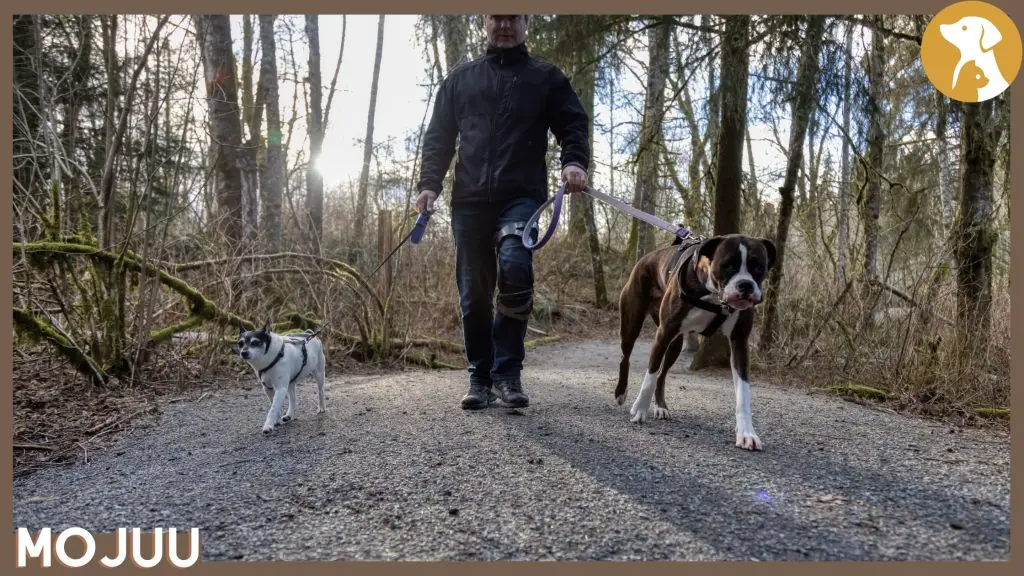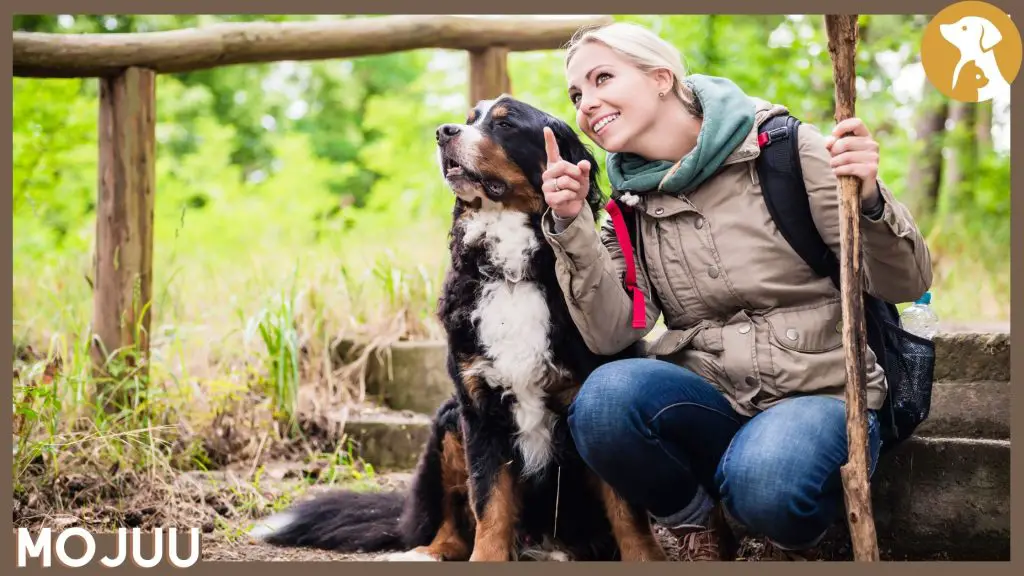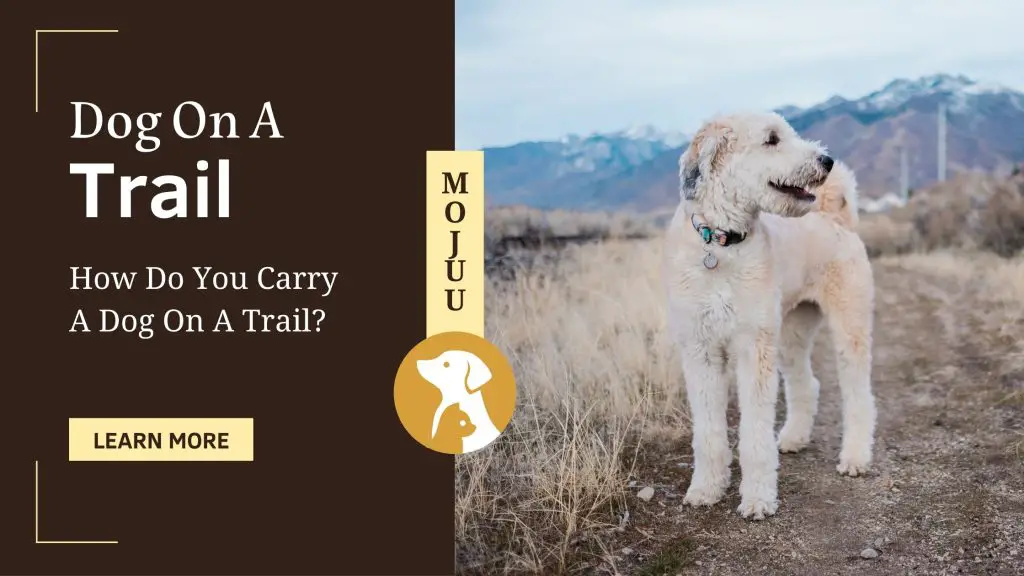Embarking on a trail adventure with your furry friend is not just a stroll in the park; it’s a bonding experience that can create lasting memories. However, when your dog faces mobility challenges or simply needs a break, knowing how to carry them becomes crucial. In this comprehensive guide, we’ll explore the ins and outs of carrying your dog on a trail, addressing various scenarios from small pups to large dogs that may find it challenging to walk.
As pet owners, we understand the dilemma – the desire to explore the great outdoors conflicting with the responsibility to ensure our dog’s comfort and safety. Fear not! We’ve compiled a range of practical tips and techniques to help you carry your canine companion with ease, ensuring an adventure that both of you can cherish. So, leash up and get ready to discover the art of carrying a dog on a trail like a pro.
Understanding Your Dog’s Needs

Before strapping on a dog carrier or attempting any carrying technique, it’s essential to understand your dog’s needs and communicate with them effectively. Dogs, like humans, have their physical limits, and it’s crucial to be attuned to signs that may indicate your furry friend needs a helping paw.
Recognizing Signs of Discomfort
Dogs express discomfort in various ways. Keep an eye out for signs such as limping, slowing down, or reluctance to continue walking. If your dog suddenly sits down during a trail, it might be an indication that they need a break or assistance.
Assessing Physical Condition
Consider your dog’s age, size, and health conditions. Older dogs or those with medical issues may require more frequent breaks or specific carrying methods. Consult with your vet if you have concerns about your dog’s ability to handle a trail hike.
Ensuring Adequate Rest
Even the most energetic dogs need rest. Plan breaks during your trail adventure, allowing your furry companion to recharge. Bring along a comfortable mat or blanket where your dog can relax, ensuring they remain energized and ready for the next leg of the journey.
Understanding your dog’s needs lays the foundation for a successful trail adventure. In the next sections, we’ll delve into specific scenarios, starting with the challenge of carrying a dog that can’t walk.
How to Carry a Dog that Can’t Walk

Carrying a dog that can’t walk requires careful consideration and the right gear to ensure both your comfort and your canine friend’s safety. Here, we explore various methods tailored to different situations.
Utilizing Dog Carriers
Investing in a quality dog carrier is a game-changer when it comes to carrying a dog that can’t walk. These carriers come in backpack-style or sling designs, providing a secure and comfortable space for your furry companion.
Backpack-style Carriers: Ideal for small to medium-sized dogs, backpack-style carriers allow your dog to enjoy the scenery while keeping them close. Look for carriers with padded straps and ample ventilation to ensure both you and your dog stay comfortable.
Sling Carriers: Sling carriers are a great option for small dogs or puppies. These lightweight carriers rest over your shoulder, keeping your dog snuggled close. Ensure the sling provides proper support and doesn’t put strain on your neck or back.
Improvised Carrying Techniques
In situations where a dedicated carrier isn’t available, you can get creative with improvised carrying techniques.
Blanket or Towel Carry: For smaller dogs, a blanket or towel carry can be effective. Place the blanket under your dog’s belly and support each end, allowing you to lift them comfortably. This method is suitable for short distances.
Fireman’s Carry: For medium to large dogs, the fireman’s carry involves lifting your dog onto your shoulders with their front legs over one shoulder and their hind legs over the other. This method requires strength and should be used cautiously.
Considering Safety Measures
Regardless of the carrying method chosen, safety should always be a priority.
- Secure Straps and Zippers: Ensure that all straps and zippers on your dog carrier are securely fastened to prevent any accidental openings. A secure carrier is vital for your dog’s safety during the journey.
- Frequent Breaks: Even if you have a comfortable carrier, remember to take frequent breaks to allow your dog to stretch and relieve themselves. This is crucial for their physical well-being on the trail.
Carrying a dog that can’t walk demands a thoughtful approach. In the next sections, we’ll explore how to carry a dog around and the specific considerations for carrying a big dog on your back.
How Do You Carry a Dog Around?

Carrying a dog around requires adaptability and understanding your dog’s preferences. It’s not just about picking them up and moving; it’s about ensuring they feel secure and comfortable throughout the journey.
Picking Up Small to Medium Dogs
For smaller breeds, simply scooping them up into your arms may be sufficient. However, take note of their comfort level. Some dogs prefer being held close, while others may feel more secure when they can see the surroundings. Experiment with different holding positions to find what works best for your furry friend.
Harness and Leash Combo
An excellent way to carry a dog around, especially if they are medium-sized, is using a harness and leash combination. Lift them gently using the harness while the leash provides additional security. This method allows for better control and helps distribute the dog’s weight more evenly.
Training for Comfort
It’s essential to accustom your dog to being carried, especially if it’s not a regular occurrence. Gradually introduce them to the sensation of being lifted, offering treats and positive reinforcement to create a positive association.
How Do You Carry a Big Dog on Your Back?
Carrying a large dog on your back requires careful planning and the right equipment to ensure both of you are safe and comfortable during the hike.
Specialized Dog Backpacks
Invest in a high-quality dog backpack designed for larger breeds. These backpacks come with sturdy frames and padded compartments, allowing your big dog to sit comfortably while you carry them on your back. Ensure the backpack is appropriately sized to accommodate your dog’s dimensions.
Proper Weight Distribution
When carrying a big dog on your back, it’s crucial to distribute the weight evenly. Adjust the straps of the backpack to ensure a secure fit and minimize strain on your back and shoulders. Practice walking with your dog in the backpack before hitting the trail to get both of you accustomed to the experience.
Checking Your Dog’s Comfort
Regularly assess your dog’s comfort during the hike. Ensure they have enough space to move around and that the backpack provides proper ventilation. If your dog shows signs of discomfort or distress, take a break and reevaluate the carrying method.
In the upcoming sections, we’ll tackle specific concerns, including backpacking with a dog and dealing with a dog that refuses to walk. Stay tuned for valuable insights to make your trail adventures with your furry friend truly enjoyable.
Can You Go Backpacking with a Dog?
The prospect of backpacking with your dog adds an extra layer of excitement to your outdoor adventures. However, it’s crucial to approach backpacking with your furry friend thoughtfully to ensure a positive experience for both of you.
Choosing the Right Trail
Not all trails are created equal, and the same goes for dogs. Before embarking on a backpacking trip, research dog-friendly trails that cater to your dog’s fitness level and preferences. Look for well-maintained paths with suitable terrain and consider any regulations regarding dogs on the trail.
Selecting Appropriate Gear
Backpacking requires a bit of gear preparation, and when your dog is your companion, additional considerations come into play.
- Dog-Friendly Backpacks: Invest in a backpack specifically designed for dogs. These backpacks are equipped with compartments for essentials like water, food, and even a small first aid kit. Make sure the backpack is comfortable for your dog and allows them to move freely.
- Collapsible Food and Water Bowls: Keep your dog well-hydrated and nourished during the backpacking trip by bringing collapsible bowls. These are easy to carry and ensure your dog has access to food and water when needed.
- Dog Booties: If your backpacking trail involves rough terrain, protect your dog’s paws with durable booties. This is especially important for breeds with sensitive paws.
Training for Backpacking Success
Before hitting the trail, ensure your dog is comfortable with the backpack and associated gear. Gradually introduce them to the backpack, allowing them to wear it for short periods indoors. Positive reinforcement, such as treats and praise, will create a positive association.
Frequent Breaks and Check-Ins
While backpacking, remember that your dog may need more breaks than you do. Schedule regular stops to allow your dog to rest, hydrate, and explore their surroundings. Keep a close eye on their behavior, especially if it’s their first backpacking experience, and adjust your pace accordingly.
Backpacking with your dog can be a rewarding experience, strengthening the bond between you and your furry companion. In the following sections, we’ll address common concerns, including the easiest way to carry a dog and what to do if your dog refuses to walk. Let’s ensure that your backpacking adventure is memorable for all the right reasons.
What is the Easiest Way to Carry a Dog?

Carrying your dog should be a comfortable and hassle-free experience for both you and your furry friend. Let’s explore the easiest ways to carry a dog, making your trail adventures more enjoyable.
Using a Dog Sling
For small to medium-sized dogs, a dog sling can be the easiest and most convenient way to carry them. These slings typically rest over your shoulder, allowing your dog to relax comfortably against your body. The hands-free design lets you navigate the trail with ease while keeping your furry companion close.
Adjustable Straps
Choose a dog sling with adjustable straps to ensure a secure fit and optimal comfort for both you and your dog. The sling should rest snugly against your body without causing strain.
Proper Support
Ensure that the dog sling provides adequate support for your dog’s body. The goal is to distribute their weight evenly and prevent any discomfort during the journey.
Backpack-style Carriers for Small Dogs
For smaller breeds, a backpack-style carrier can be incredibly easy to use. These carriers allow your dog to enjoy the view while keeping them securely contained.
Ventilation and Visibility
Opt for a backpack with mesh windows for proper ventilation and visibility. This not only keeps your dog cool but also allows them to observe their surroundings.
Padded Straps for Comfort
Choose a backpack with padded shoulder straps to enhance your comfort while carrying your dog. The padding helps prevent strain on your shoulders and back.
Considering Your Dog’s Preferences
The easiest way to carry a dog ultimately depends on your dog’s preferences. Some dogs may feel more comfortable in a sling, while others may prefer the elevated view provided by a backpack-style carrier. Observe your dog’s reactions and choose the method that aligns with their comfort.
In the subsequent sections, we’ll address concerns related to dogs refusing to walk and how to carry a small dog while hiking. By understanding the easiest ways to carry your dog, you’ll be well-prepared for a seamless trail experience.
Should I Carry My Dog if He Refuses to Walk?

It’s not uncommon for dogs to refuse to walk, especially during unfamiliar or challenging terrain. In such situations, understanding the reasons behind their reluctance and adopting appropriate strategies can make the trail experience more enjoyable for both you and your furry companion.
Understanding Your Dog’s Discomfort
Several factors can contribute to a dog refusing to walk:
Physical Discomfort: Check your dog for signs of physical discomfort, such as limping or sensitivity in certain areas. If you notice anything unusual, it’s best to refrain from forcing them to walk and seek veterinary advice.
New environments or unexpected stimuli on the trail can trigger fear or anxiety in dogs. Be patient and allow your dog time to acclimate to their surroundings. Gradual exposure and positive reinforcement can help build their confidence.
Encouraging Your Dog to Walk
If your dog is hesitant to walk, there are strategies to encourage them without resorting to carrying:
Use Treats and Positive Reinforcement: Entice your dog with treats, toys, or praise to create a positive association with walking. Reward them when they take steps or show interest in moving forward.
Take Shorter Walks Initially: If your dog is new to trail walking, start with shorter walks to gauge their comfort level. Gradually increase the distance as they become more accustomed to the trail environment.
Explore Familiar Trails Choose trails that are familiar to your dog. They may feel more at ease in surroundings they recognize, making them more likely to walk willingly.
When to Consider Carrying Your Dog
While encouraging your dog to walk is ideal, there are situations where carrying becomes a suitable option:
Medical Reasons If your dog has a medical condition that affects their mobility, carrying may be necessary. Consult with your vet to determine the best approach and ensure your dog’s well-being.
Safety Concerns In hazardous or challenging terrain, carrying your dog ensures their safety. This is especially true for steep or rocky trails where your dog may struggle to navigate.
Understanding when to encourage and when to carry your dog contributes to a positive trail experience. In the next sections, we’ll explore whether dogs enjoy being carried and how to move a large dog that can’t walk. Let’s ensure your trail adventures remain enjoyable for both you and your furry friend.
How Do You Carry a Small Dog While Hiking?
Carrying a small dog while hiking requires a combination of practical gear, comfort considerations, and a dash of creativity. Small dogs may tire quickly or face challenges on the trail, making it essential to have a reliable method to ensure their safety and enjoyment.
Choosing the Right Carrier
Selecting an appropriate carrier for your small dog is paramount for a comfortable hiking experience. Here are two popular options:
Front Carrier
A front carrier allows you to carry your small dog against your chest. This setup provides a sense of security for your dog, allowing them to observe the trail while staying close to you. Look for a carrier with adjustable straps and proper ventilation.
Backpack-style Carrier
Similar to the backpacks for bigger dogs, these carriers are designed for smaller breeds. They offer a secure compartment for your dog to sit comfortably, with openings for their head and legs. Ensure the carrier is well-padded and has a secure enclosure.
Gradual Introduction to the Carrier
Before hitting the trail, let your small dog become familiar with the carrier. Place treats or their favorite toy inside to create positive associations. Allow them to explore the carrier at home before attempting to use it on a hike.
Regular Breaks and Check-ins
Even in a carrier, small dogs can benefit from breaks to stretch their legs and explore. Plan regular stops where you can take your dog out of the carrier, allowing them to walk around and enjoy the surroundings. This also helps prevent stiffness and ensures their comfort.
Consider the Trail Terrain
The type of trail you choose influences the best method for carrying your small dog. For rough or uneven terrain, a secure backpack-style carrier might be more suitable, providing protection and stability. On smoother trails, a front carrier can offer a more interactive experience for your dog.
Do Dogs Like When We Carry Them?

Many dogs enjoy being carried, especially if it’s done in a way that makes them feel secure and close to their owner. However, individual preferences vary. Pay attention to your dog’s body language and reactions. If they seem relaxed, content, and show no signs of distress, it’s likely they appreciate the extra attention and closeness.
In the next section, we’ll explore the logistics of moving a large dog that can’t walk. Whether you have a big breed or your dog is recovering from an injury, understanding the best practices for moving large dogs is crucial for a safe and enjoyable trail experience.
How Do You Move a Large Dog That Can’t Walk?
Moving a large dog that can’t walk requires thoughtful planning and consideration for both your dog’s well-being and your own physical capabilities. Let’s explore effective methods and equipment for safely transporting large dogs during hiking or trail adventures.
Using a Dog Stretcher or Sled
For large dogs unable to walk due to injury or fatigue, a dog stretcher or sled can be a practical solution. These devices are designed to comfortably carry dogs while distributing their weight evenly.
Sturdy Construction, Choose a stretcher or sled with a sturdy frame and durable materials. This ensures stability and safety during transport. Some models come with adjustable features to accommodate different dog sizes.
Comfortable Padding, Ensure the stretcher or sled has sufficient padding to keep your dog comfortable during the journey. Look for options with removable and washable padding for easy maintenance.
Improvised Carrying Methods
In situations where specialized equipment is unavailable, you can improvise carrying methods for large dogs:
Two-Person Carry, Enlist the help of a second person to assist in carrying the large dog. This can be achieved by each person supporting one end of the dog. Communication and coordination are crucial to ensure a smooth and safe transport.
Blanket or Towel Carry, Similar to carrying small dogs, you can use a blanket or towel to lift and support a large dog. This method may be suitable for short distances or situations where other options are unavailable.
Ensuring Safety During Transport
Regardless of the method chosen, safety considerations are paramount:
- Gentle Handling Handle your large dog with care, ensuring that their limbs are properly supported. Avoid sudden movements or jostling, as this can cause discomfort or exacerbate any existing injuries.
- Frequent Breaks, Even with the assistance of a stretcher or sled, take regular breaks to allow your dog to rest and reposition. This is crucial for preventing fatigue and ensuring their well-being during the journey.
- Consult with a Veterinarian, Before attempting any form of transport for a large dog with mobility issues, consult with your veterinarian. They can provide guidance on the best methods based on your dog’s specific condition.
In the following sections, we’ll explore whether dogs enjoy being carried and address common concerns, such as how to carry a dog that refuses to walk. Stay tuned for insights that will enhance your trail adventures with your canine companion.
How to Carry a Dog that Refuses to Walk
Encountering a situation where your dog refuses to walk can be perplexing, but understanding the reasons behind their reluctance and employing effective strategies can turn the situation around. Let’s explore how to address this common concern and ensure a positive walking experience for both you and your furry friend.
Understanding Reasons for Refusal
Dogs may refuse to walk for various reasons, and identifying the cause is the first step toward finding a solution:
Fear or Anxiety: New environments, unfamiliar sounds, or encounters with other animals can trigger fear or anxiety in dogs. It’s essential to recognize these stressors and gradually acclimate your dog to the walking environment.
Medical Issues: Pain or discomfort due to an injury or underlying health condition can lead to reluctance to walk. If your dog’s behavior changes suddenly, consider consulting with your veterinarian to rule out any health concerns.
Overexertion: Dogs, like humans, can tire easily. If your dog has been walking for an extended period or is not accustomed to physical activity, they may refuse to continue. Offer water, allow breaks, and adjust the pace accordingly.
Strategies to Encourage Walking
Once you’ve identified the root cause of your dog’s reluctance, consider the following strategies to encourage them to walk:
Positive Reinforcement: Use treats, praise, or toys to create positive associations with walking. Reward your dog when they take steps or show interest in moving forward. This reinforces the idea that walking is a rewarding and enjoyable activity.
Gradual Exposure: For dogs with fear or anxiety, gradual exposure is key. Start with short walks in familiar surroundings, then slowly introduce new environments. Patience is crucial as your dog builds confidence.
Adjust the Walking Route: Choose walking routes that cater to your dog’s preferences. Some dogs may prefer quiet paths away from busy streets, while others enjoy the bustle of a more populated area. Tailor the route to suit your dog’s comfort level.
Seek Professional Guidance: If your dog’s refusal to walk persists or is accompanied by behavioral changes, consider seeking guidance from a professional dog trainer or behaviorist. They can provide personalized strategies based on your dog’s specific needs.
Understanding your dog’s cues and employing positive reinforcement techniques can transform a reluctant walker into an eager trail companion. In the subsequent sections, we’ll delve into carrying small dogs while hiking and explore whether dogs enjoy being carried. Let’s ensure your walking and hiking experiences with your canine friend are enjoyable and stress-free.
Conclusion
Embarking on trail adventures with your canine companion is a delightful experience that strengthens the bond between you and your furry friend. Knowing how to carry a dog on a trail, whether they are small and energetic or large and needing assistance, opens up new possibilities for shared exploration. By understanding your dog’s needs, choosing appropriate carriers, and employing positive reinforcement, you can ensure a comfortable and enjoyable trail experience for both you and your four-legged friend.
Remember to be attuned to your dog’s body language, preferences, and any signs of discomfort. Gradual exposure, positive associations, and respecting your dog’s limits contribute to a positive walking or carrying experience. Whether your dog enjoys being carried or prefers exploring on their own, tailoring your approach to their unique personality ensures a harmonious journey on the trails.
FAQs – Trail Adventures with Your Dog
- Q: Can I carry my dog in any type of carrier?
A: The type of carrier depends on your dog’s size and your preferences. Backpack-style carriers are suitable for small to medium dogs, while stretchers or sleds may be necessary for larger dogs with mobility issues. - Q: How do I train my dog to enjoy being carried?
A: Gradual exposure and positive reinforcement are key. Use treats, toys, and praise to create positive associations with being carried. Allow your dog to explore carriers at home before attempting to use them on the trail. - Q: What if my dog refuses to walk during a hike?
A: Identify the reason for refusal, whether it’s fear, anxiety, medical issues, or overexertion. Use positive reinforcement, adjust the walking route, and seek professional guidance if needed. - Q: Is it safe to carry a large dog on a trail?
A: Using a dog stretcher or improvised methods with caution can be safe for carrying large dogs. Ensure proper support, frequent breaks, and consult with a veterinarian if your dog has mobility issues. - Q: Do all dogs enjoy being carried?
A: Individual preferences vary. If they appear relaxed and content, they likely enjoy being carried. Respect their limits and preferences.
Embark on your trail adventures with confidence, knowing that your understanding of your dog’s needs and effective carrying techniques will make the experience enjoyable for both of you. Happy trails!







